1. Overview
Rhythmbox is an audio player that supports multiple audio formats, including MP3. Additionally, we can use it to organize music, create playlists, listen to podcasts, and stream Internet radio.
In this tutorial, we’ll explore playing MP3 files using Rhythmbox in Ubuntu.
2. Installing Rhythmbox
We can install Rhythmbox in Ubuntu using the apt package manager. First, we need to update the package list to ensure we get the latest version:
$ sudo apt update
Next, let’s install Rhythmbox:
$ sudo apt install rhythmbox
Once the installation is complete, we can verify it by checking its version:
$ rhythmbox --version
rhythmbox 3.4.4
Above, we see the installed version of Rhythmbox is rhythmbox 3.4.4.
3. Understanding the Rhythmbox Interface
The Rhythmbox interface is divided into multiple sections:
- Library Pane – represents the left side of the window where we can browse our music library, playlists, podcasts, and radio channels
- Main Window – represents the central part of the window where the selected content, such as music library or current playlist, is displayed
- Player Controls – represents the controls at the bottom used for playing, pausing, and skipping tracks
Now, let’s go ahead and play MP3 files using Rhythmbox.
4. Adding and Playing MP3 Files in Rhythmbox
First, we’ll launch Rhythmbox from the applications menu:
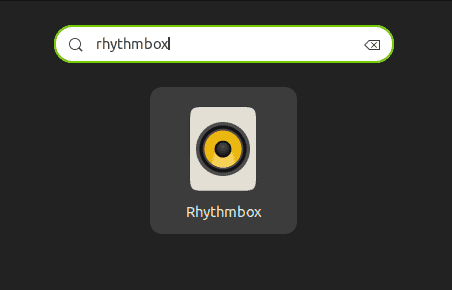
Next, we’ll add the MP3 files to the Rhythmbox library. We can do this by dragging and dropping the MP3 files or folders containing the MP3 files into the Rhythmbox window.
On the other hand, we can use the import feature by selecting Music on the left sidebar and clicking the Import button at the Music window’s top-left corner:

Here, we’ll click the dropdown menu next to the Select a location containing music to add to your library option and navigate to the directory containing the MP3 files. We’ll select the directory and click the Open button to add the MP3 files:
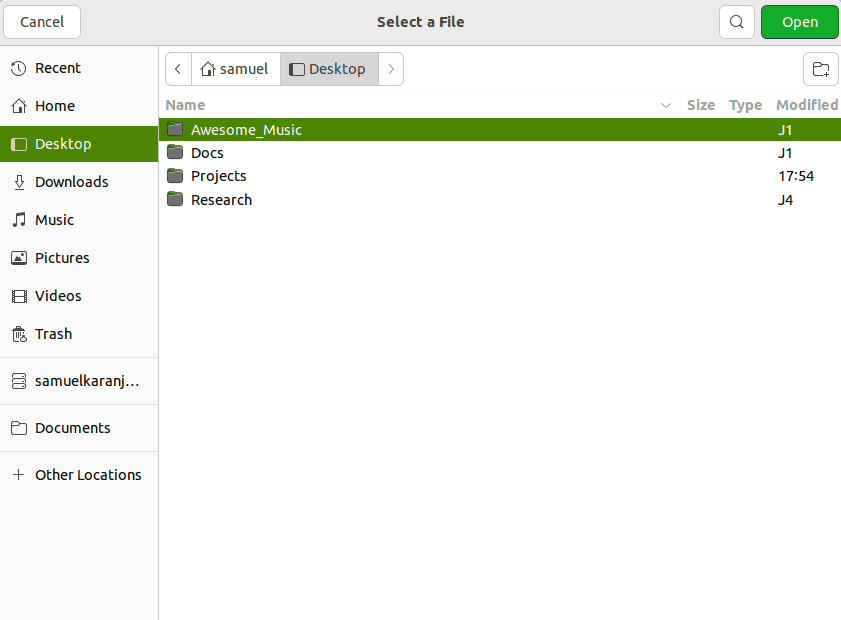
Once we add the MP3 files, we’ll click the Import listed tracks button to upload them to the Music library:
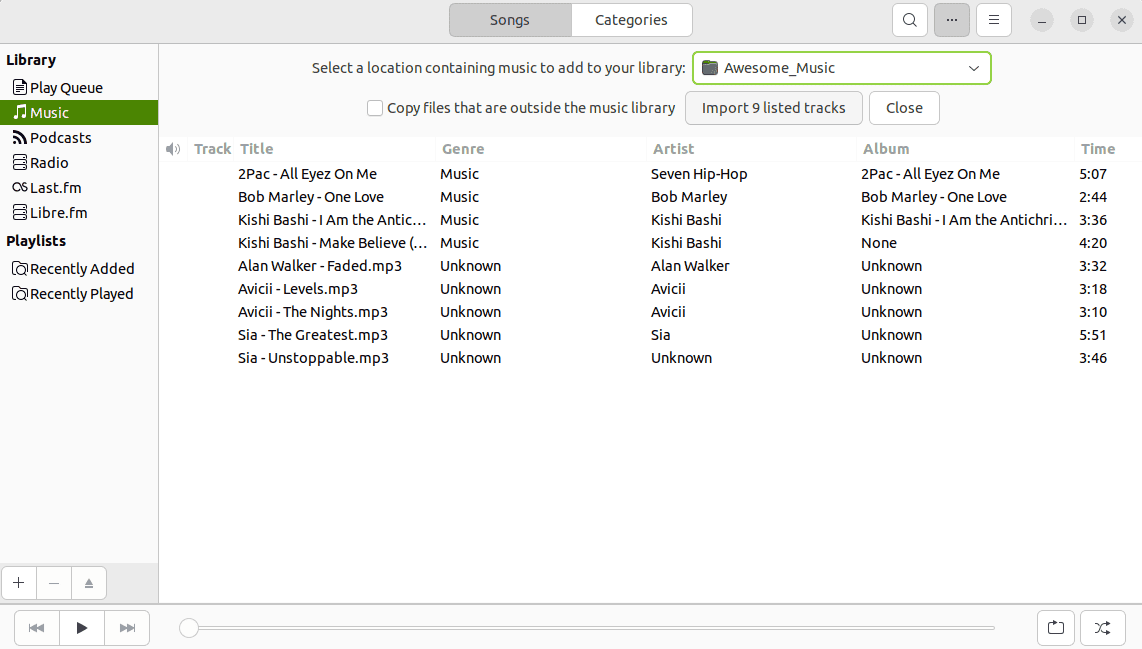
To play the MP3 files, we’ll select a file from the Music Library and double-click on it. Alternatively, we can use the playback controls at the bottom of the Rhythmbox window:
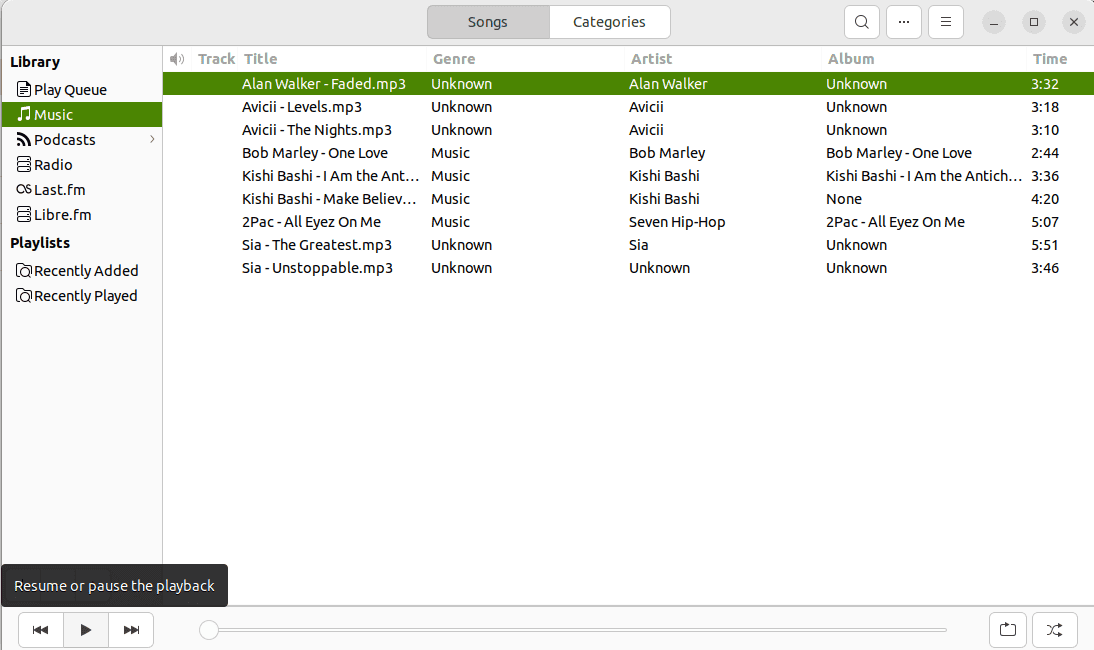
In addition, we can shuffle and repeat the MP3 files using the playback controls.
5. Creating and Managing Playlists
Rhythmbox makes it easier to organize MP3 files by allowing us to create and manage playlists according to our preferences. On the side menu, we’ll see a section labeled Playlists. This is where all the available playlists are located.
Now, to create a new playlist, we’ll click the + button at the bottom of the side menu and select the New Playlist option:
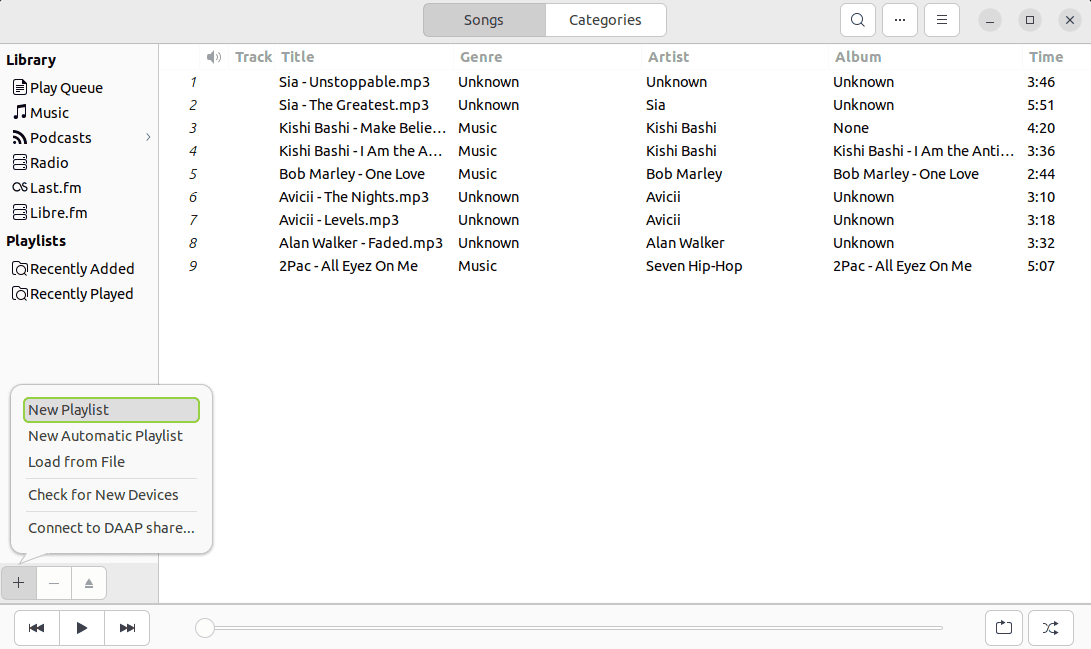
At this point, a new playlist entry will appear under Playlists. It will be highlighted, prompting us to enter the name. We’ll type in a name for our playlist and press the Enter key:

Above, we create a playlist named Favourites. Now, to add an MP3 file to the playlist, we’ll navigate back to the Music library. Here, we’ll right-click on an MP3 file, select the Add to Playlist option, and choose the playlist we created, which in this case is Favourites:
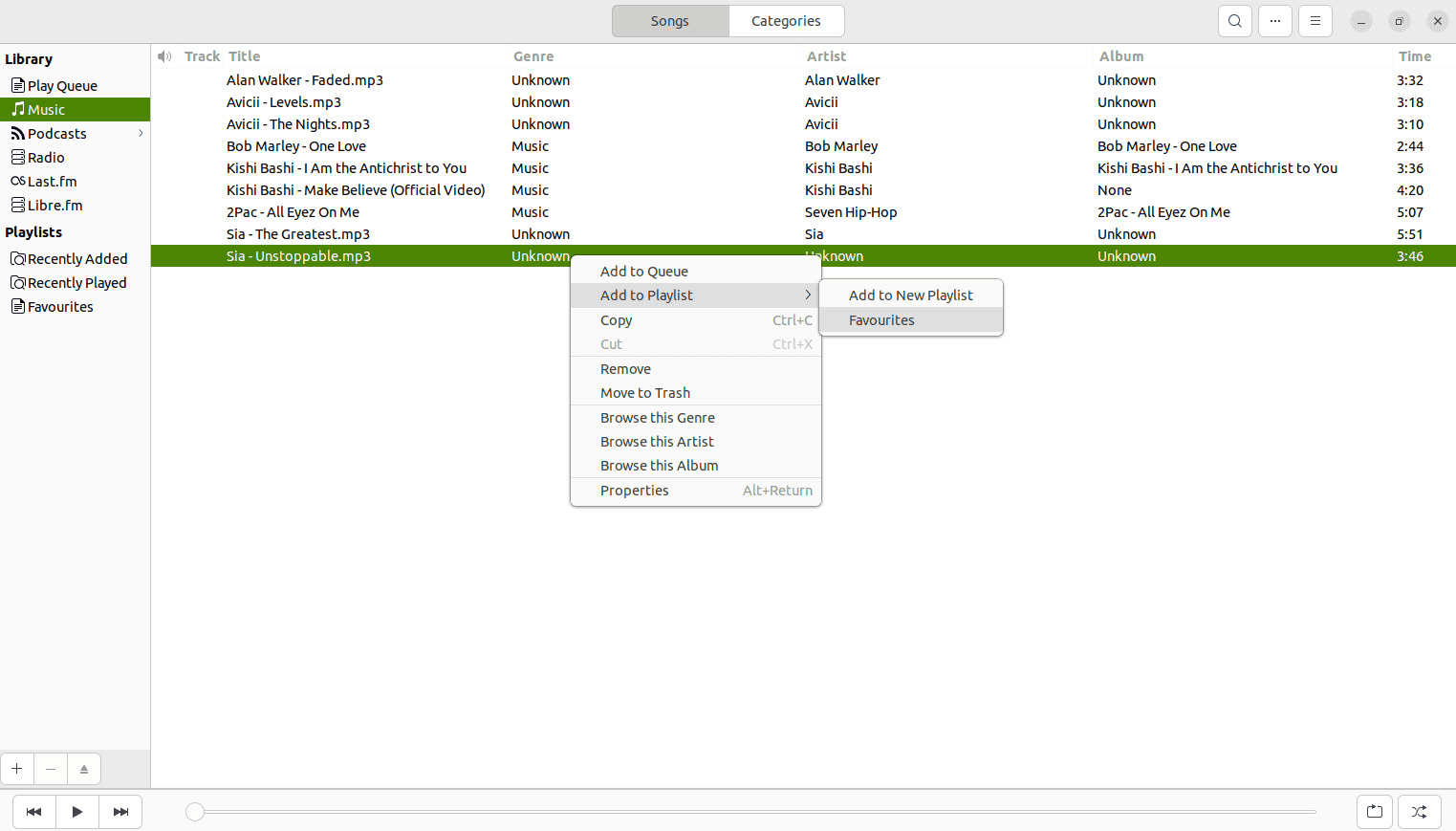
We’ll repeat the above steps to add multiple MP3 files to the playlist. Alternatively, we can drag and drop the MP3 files from the Music library into the playlist.
Finally, to remove an MP3 file from the playlist, we’ll right-click on the MP3 file and select the Remove from Playlist option:
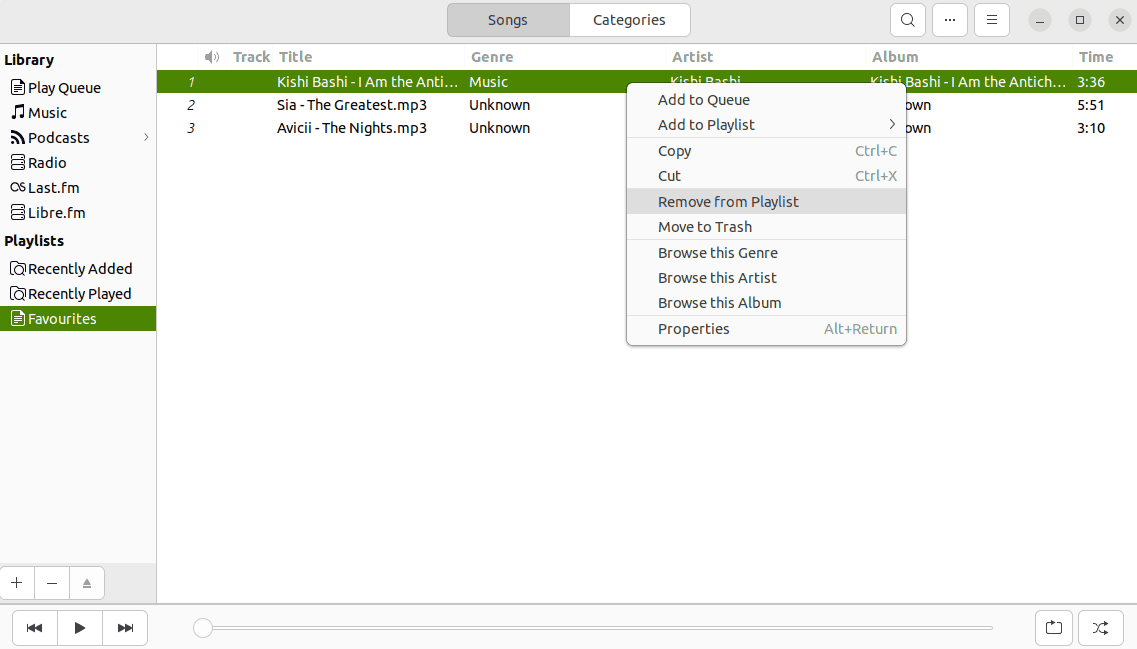
6. Using the Play Queue
The Play Queue feature allows us to manage what MP3 files will play next without changing the existing playlists or music library.
To add an MP3 file to the queue, we’ll navigate the music library to find the file we want to play. Next, we’ll right-click on the file and select Add to Queue from the context menu:

Once we add all the MP3 files we want to the queue, we’ll click Play Queue on the left sidebar to view the files. Here, a list of all MP3 files will be displayed on the Play Queue window:
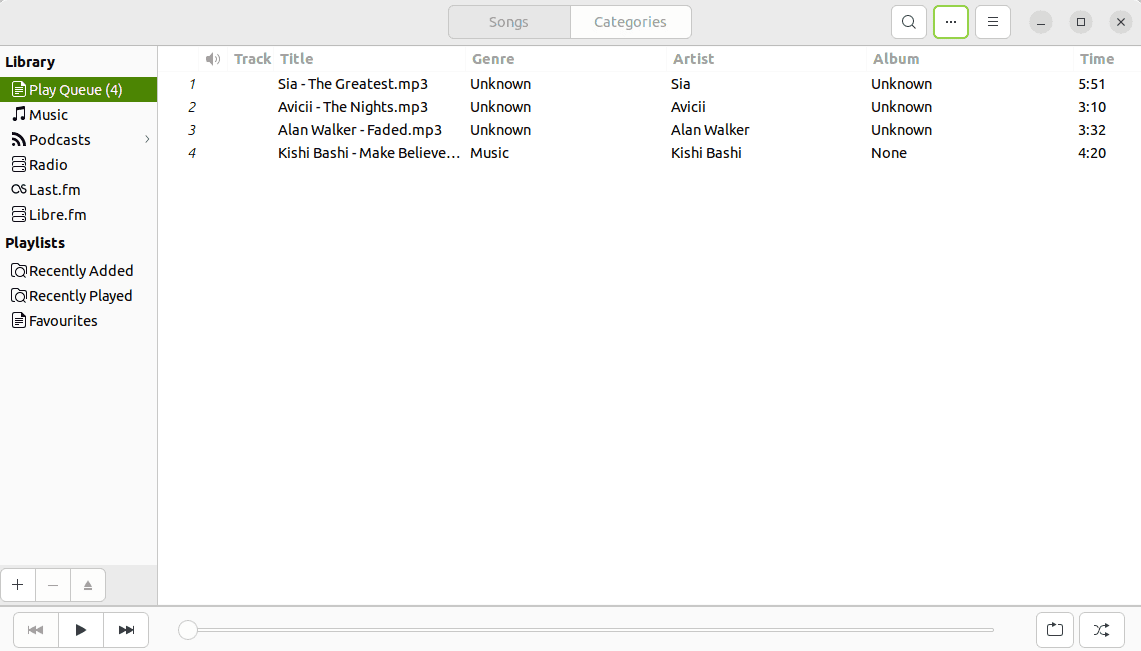
Furthermore, we can drag the MP3 files within the queue to reorder them.
Finally, to remove a file from the queue we’ll right-click on the file and select Remove from Play Queue:
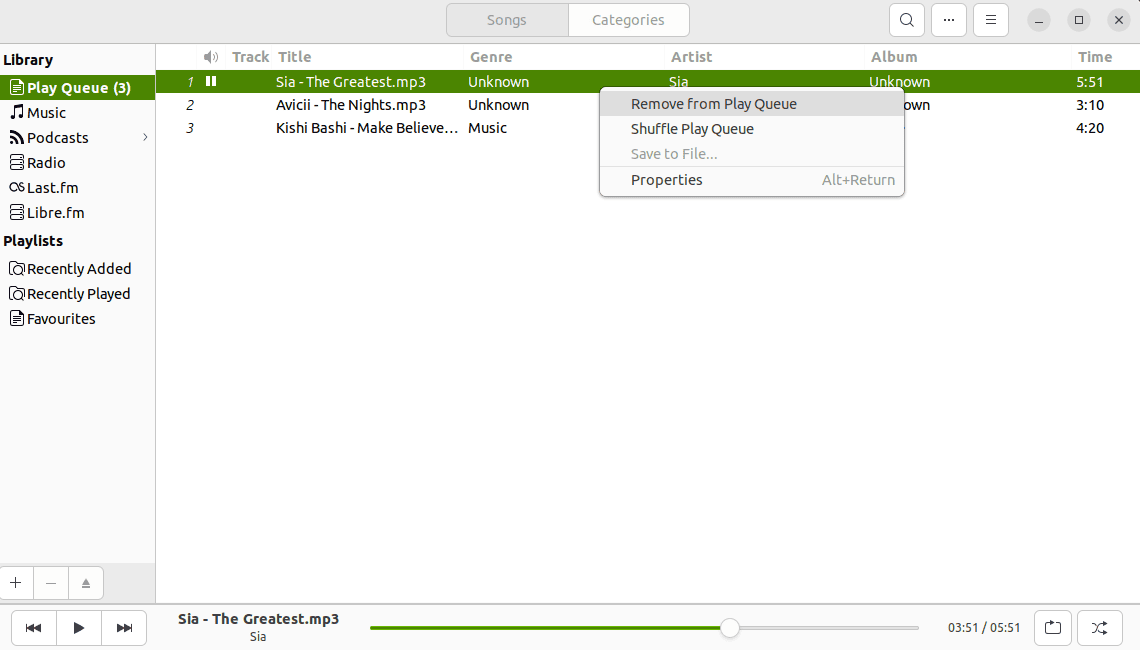
Above, we remove a specific MP3 file from the queue.
7. Advanced Features
Rhythmbox offers several additional features, such as internet radio and podcasts, that we can use to enhance our listening experience.
7.1. Internet Radio
Rhythmbox includes a built-in internet radio feature that allows us to listen to various radio stations worldwide.
To access the Internet radio, we’ll click Radio on the left sidebar menu:
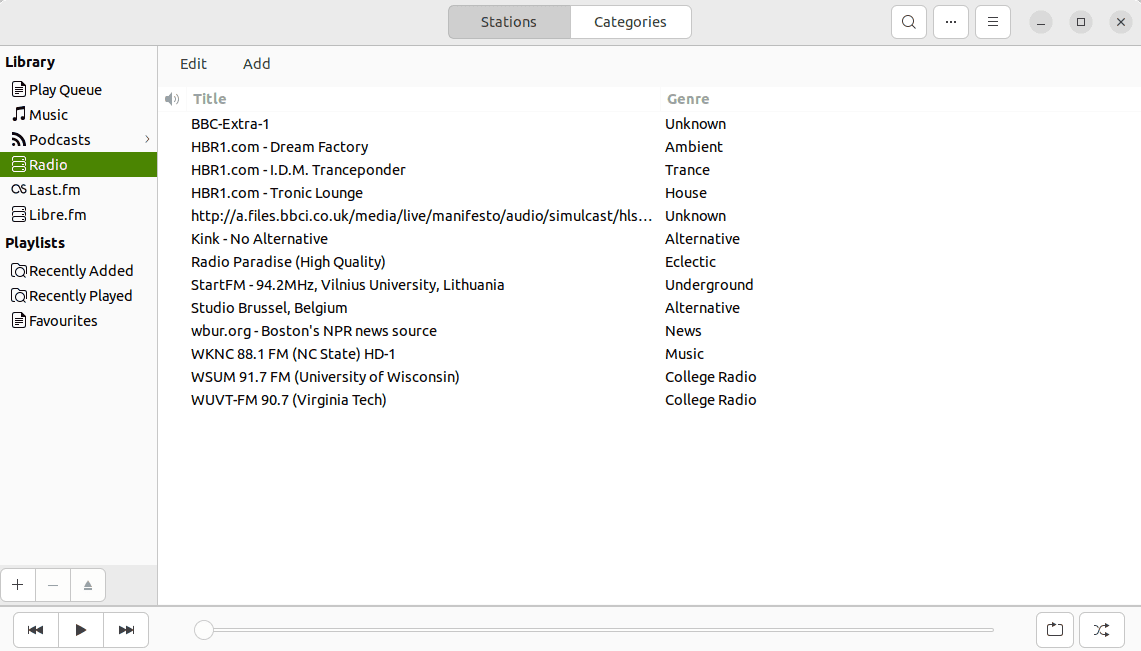
Here, we’ll double-click on a radio station from the list of available Internet radio stations to listen to it:
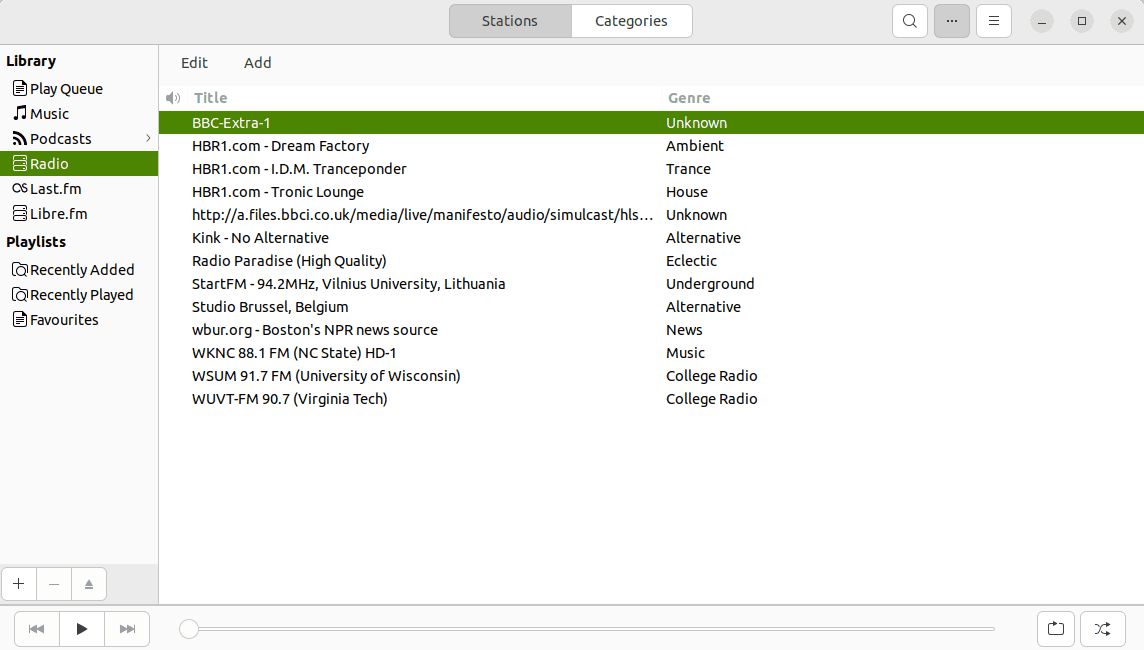
Additionally, we can add a custom radio station by clicking the Add button at the top left corner of the Internet radio section. Next, a dialog box will appear where we’ll enter the URL of the custom radio station:
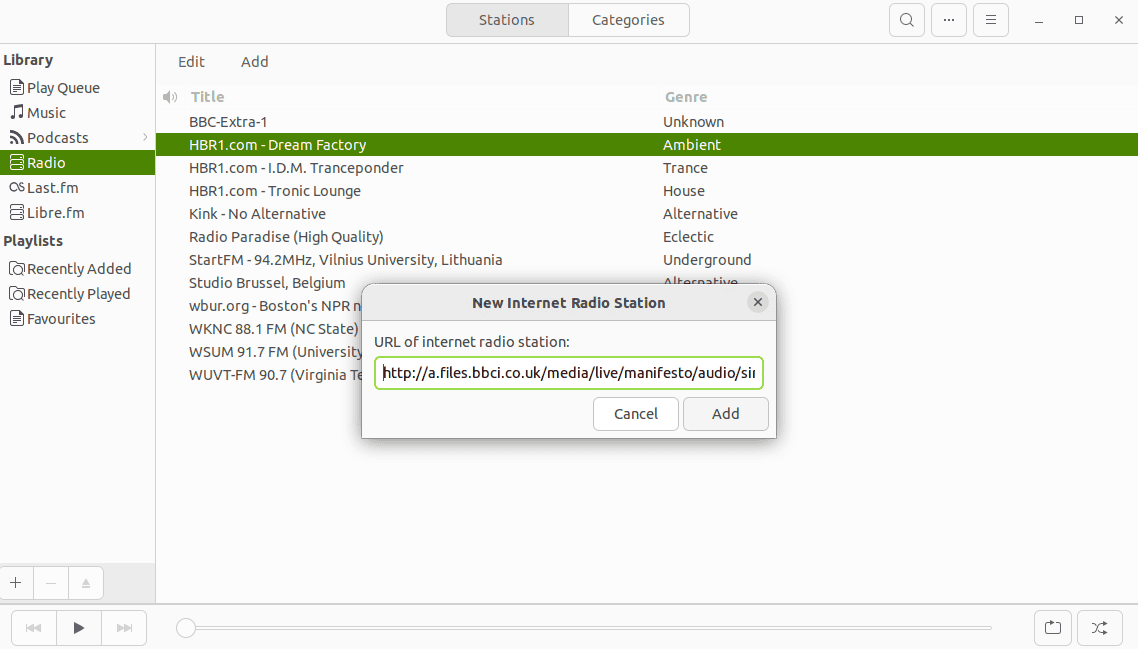
The new station will appear in our list of available stations.
7.2. Podcasts
The Rhythmbox podcast feature allows us to subscribe to, download, and manage podcasts.
We’ll select Podcast on the left sidebar menu to subscribe to a particular podcast. Now, to add a podcast, we’ll click the Add button at the top left corner of the Podcast window:

Here, we’ll enter the name of the podcast we’re interested in into the search box, and then click the Search button:
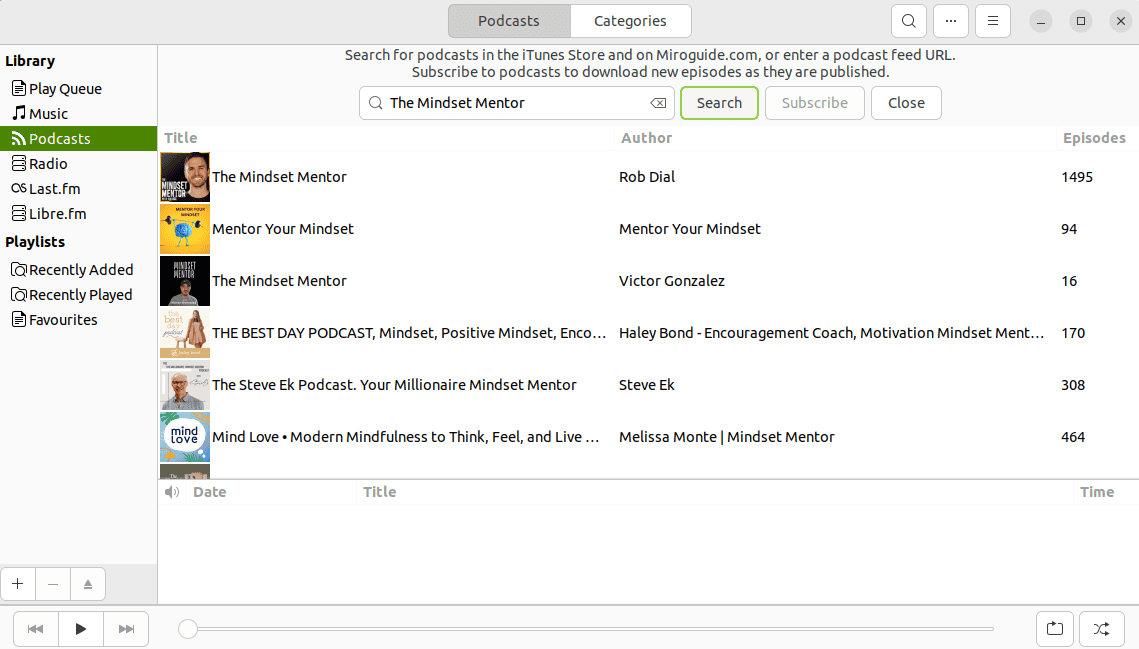
Above, a list of podcasts related to the topic we’re searching for is displayed. Once we locate the podcast we’re interested in, we’ll select it and subscribe to it by clicking the Subscribe button:
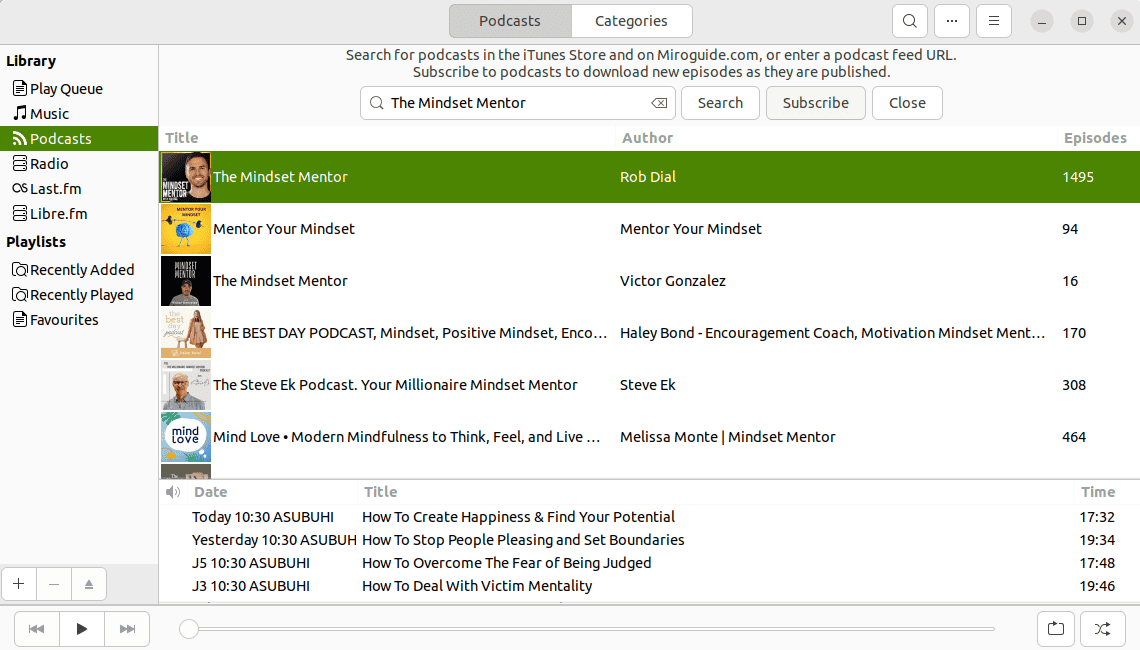
At this point, we’ll click the Close button and return to the Podcast Window. We can choose to download episodes to listen offline by right-clicking on the episode and selecting Download Episode:
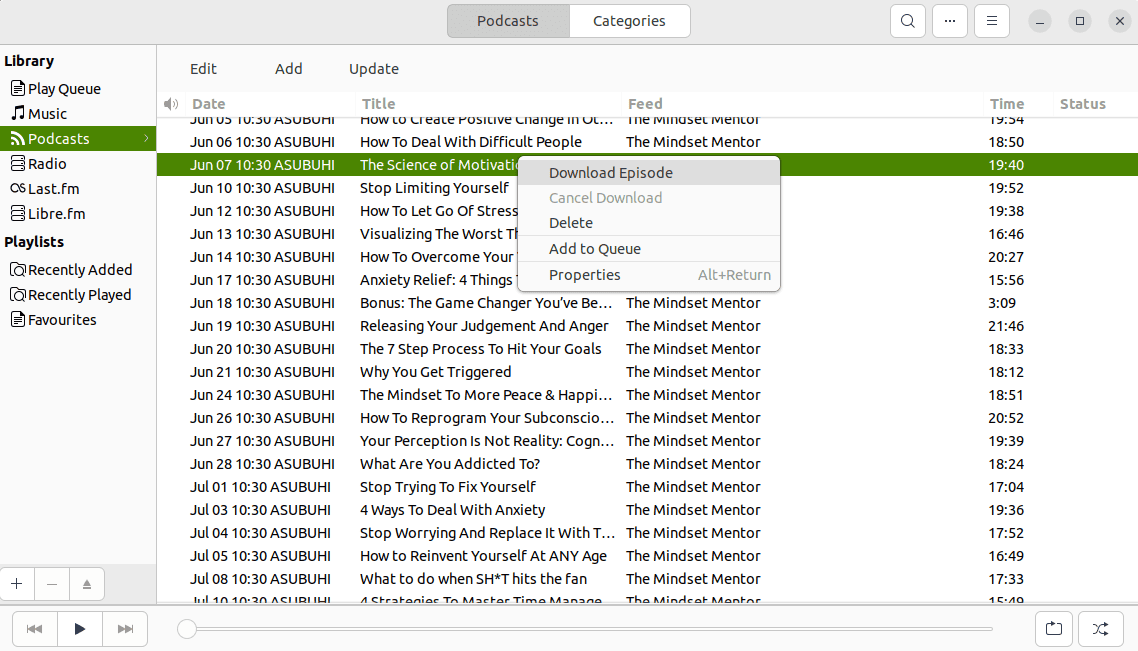
Finally, to play an episode, we’ll double-click on it.
8. Common Issues
Sometimes, we may encounter issues when we try to play MP3 files in Rhythmbox. This may occur if the codecs required for MP3 playback are missing. To resolve the problem, we’ll install the necessary codecs:
$ sudo apt install ubuntu-restricted-extras
Using the above command, we install codecs for playing MP3 and DVDs, Microsoft fonts, and other tools.
9. Conclusion
In this article, we discussed playing MP3 files in Ubuntu using Rhythmbox. Additionally, we explored how to create and manage playlists, use the play queue feature, and listen to Internet radio and podcasts.